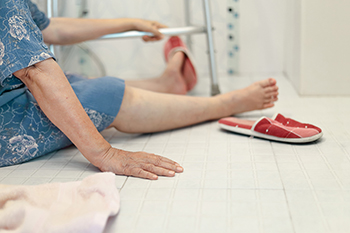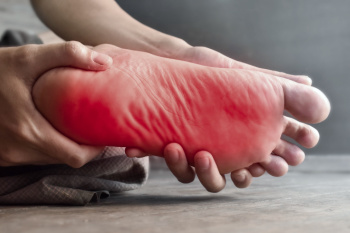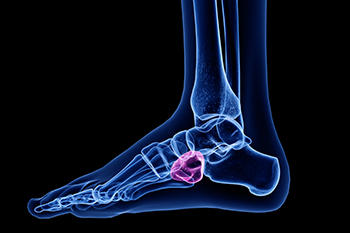Connect With Us
Blog
Items filtered by date: January 2025
Common Foot Injuries Caused by Slip and Fall Accidents

Slip and fall accidents can lead to a variety of foot injuries, ranging from mild to severe. One of the most common injuries is a sprain, which occurs when the ligaments in the foot are stretched or torn due to sudden movements. Fractures are also frequent, with broken toes or metatarsals being common after a fall. Another injury is a strain, where the muscles or tendons in the foot become overstretched or torn. In some cases, falls can lead to dislocations, where the bones in the foot are forced out of their normal position. Bruises and cuts can also occur if the foot strikes a hard surface. These injuries can be painful and may limit mobility, often requiring medical treatment, rest, and rehabilitation. Wearing proper footwear and using caution in slippery areas can help reduce the risk of such injuries. If you have endured a foot or ankle injury as a result of falling, it is suggested that you contact a chiropodist who can treat various foot conditions, and guide you on additional fall prevention methods.
Falls are a major cause of injury among the elderly. To learn more about preventing falls or to get treatment following a foot or ankle injury caused by a fall, please consult with Paul A. Scotti, D.Ch from West Toronto Foot & Ankle Clinic Inc. . Our chiropodist will assess your condition and provide you with quality foot and ankle treatment.
Falling is one of the leading causes of injury among the elderly. It is said that about 50% of falls that result in hospitalization occur in the home. Fortunately, there are steps that you can implement to reduce your risk of falling in the home.
Tips to Prevent Falls at Home:
In the bathroom - Place non-slip mats in the shower or tub, install grab bars near the toilet and bath, and wipe up any moisture or spills as soon as possible.
In the living rooms and bedroom - Remove loose wires, cords, or other objects that may be an obstacle to moving around safely. Make sure that you have good lighting throughout the home so that you can always see where you are going. Get rid of any rugs or mats that are not firmly anchored or that may cause you to trip. When walking around the home, move slowly.
In the kitchen - Store food and supplies in easily accessible areas, store heavy items in lower cupboards, and wipe up any spills immediately to prevent slipping.
On the stairs - Make sure that the stairs are well-lit and have secure handrails. Walk slowly when ascending or descending the stairs.
Outside - Keep walkways well-lit and clear of snow, ice, leaves, and man-made tripping hazards.
Maintaining your overall health, including the health of your feet, can also help to prevent falls. Eat a healthy diet, exercise regularly, and wear well-fitted, comfortable, and supportive shoes. If you have a mobility device, such as a cane, use it while walking.
If you have any questions, please feel free to contact our office located in . We offer the newest diagnostic and treatment technologies for all your foot care needs.
Facts About Diabetic Foot Neuropathy

Diabetic foot neuropathy is a condition that results from nerve damage caused by prolonged high blood sugar levels in individuals with diabetes. This condition affects the peripheral nerves, leading to symptoms such as pain, numbness, and weakness in the feet. There are several types of diabetic foot neuropathy, with the most common being peripheral neuropathy, which causes tingling and burning sensations in the feet. Another type is autonomic neuropathy, which affects the nerves controlling sweat glands and blood flow, potentially leading to dry, cracked skin on the feet. The primary cause of diabetic foot neuropathy is consistently high blood sugar levels, which damage the nerves over time. Other contributing factors include poor circulation, obesity, and long-standing diabetes. Effective management involves controlling blood sugar levels and regular foot inspections by a chiropodist. If you have diabetes, it is strongly suggested that you contact this type of healthcare professional who can help you to monitor this serious condition.
Neuropathy can cause permanent nerve damage if left untreated. If you are experiencing the symptoms of peripheral neuropathy, please consult with Paul A. Scotti, D.Ch from West Toronto Foot & Ankle Clinic Inc. . Our chiropodist will assess your condition and provide you with quality foot and ankle treatment.
What Is Peripheral Neuropathy?
Peripheral neuropathy is a condition that damages the nerves of the peripheral nervous system, which provide sensation to the limbs. The feet are often affected. Peripheral neuropathy can have many different causes, but it is most commonly associated with diabetes.
Symptoms
Common symptoms of peripheral neuropathy include:
Pain
Numbness or tingling sensation
Burning sensations
Weakness
Loss of balance
Diagnosis
Peripheral neuropathy is diagnosed based on medical history and physical examination. Various tests performed during physical examinations can help determine the type of peripheral neuropathy you may have and what is causing it.
Treatment
Treatment for peripheral neuropathy will depend on what is causing it. For example, if your peripheral neuropathy is caused by diabetes, then managing your blood sugar, exercising regularly to strengthen the legs and feet, and taking pain medications may be recommended as treatments.
If you have any questions, please feel free to contact our office located in . We offer the newest diagnostic and treatment technologies for all your foot care needs.
Symptoms of Cuboid Syndrome

Cuboid syndrome is a condition that affects the foot, specifically the cuboid bone, located on the outer side of the midfoot. It happens when the cuboid and calcaneus joint move abnormally, causing misalignment or limited movement. This misalignment can result from sudden trauma, repetitive stress, or uneven gait, often seen in athletes or individuals with poor foot mechanics. The symptoms of cuboid syndrome include pain, swelling, and difficulty walking. The pain may worsen with running, jumping, or standing for long periods. Some people may also experience a feeling of weakness or instability in the foot. Proper diagnosis and treatment, such as manual manipulation, can help realign the cuboid bone and restore normal foot function. If you have pain in your foot, it is strongly suggested that you visit a chiropodist who can provide a proper diagnosis and treatment.
Cuboid syndrome, also known as cuboid subluxation, occurs when the joint and ligaments surrounding the cuboid bone in the foot become injured. If you think that you may have cuboid syndrome, please consult with Paul A. Scotti, D.Ch from West Toronto Foot & Ankle Clinic Inc. . Our chiropodist will assess your condition and provide you with quality foot and ankle treatment.
Causes
The cuboid bone is one of the seven tarsal bones located in the foot. Cuboid syndrome develops when the cuboid bone moves down and out of alignment with the other bone (calcaneus bone) in the joint of the foot. Cuboid syndrome can be the result of a sudden injury like an ankle sprain, or it may develop slowly over time from repetitive tension through the bone and surrounding structures.
Symptoms
The most common symptom of cuboid syndrome is pain on the outside of the foot which may worsen with activity.
Other possible symptoms include:
Difficulty bearing weight on the affected foot
Swelling
Sensitivity on the bottom of the foot
Reduced range of motion
Diagnosis
A chiropodist can diagnose cuboid syndrome based on your medical history and a physical examination of the foot. Imaging studies, such as X-rays or MRIs, often fail to show the dislocated cuboid.
Treatment
Treatment often includes resting, icing, compressing and elevating the affected foot, taping, wearing orthotic inserts, and taking anti-inflammatory medications to reduce pain. The chiropodist may also be able to manipulate the dislocated bone back into alignment.
If you have any questions, please feel free to contact our office located in . We offer the newest diagnostic and treatment technologies for all your foot care needs.
Reminder: When Was the Last Time...?
Recognizing Symptoms of Diabetic Feet

Diabetic feet can cause problems due to poor circulation and nerve damage. One of the primary symptoms is numbness or tingling in the feet, known as diabetic neuropathy, which can make it difficult to sense injury or infection. People with diabetes may also notice their feet becoming dry, cracked, or callused, as the skin loses moisture and becomes less flexible. Poor circulation can lead to cold feet, slow healing of cuts or wounds, and changes in skin color. In severe cases, ulcers or infections can lead to tissue damage. Regular foot inspections and proper foot care are essential for those with diabetes to prevent complications and maintain foot health. If you have diabetes, it is strongly suggested that you are under the care of a chiropodist who can help you manage this serious condition.
Diabetes can cause serious problems in the lower limbs if proper preventive measures are not taken and diabetic wound care is not performed. If you would like to learn more about caring for diabetic feet, please consult with Paul A. Scotti, D.Ch from West Toronto Foot & Ankle Clinic Inc. . Our chiropodist can help you maintain the health of your lower limbs and your mobility.
Diabetes can lead to a host of foot and ankle complications, including:
Poor circulation
Peripheral neuropathy
Diabetic foot wounds and ulcers
Infection
Corns and calluses
Dry, cracked skin
Nail disorders
Hammertoes
Bunions
Charcot foot
If you have diabetes, you must be vigilant of any changes in your foot health. This is best done through daily foot inspections. Using a mirror to help you if necessary, look for any:
Cuts, scrapes, sores, or wounds
Bruising or discoloration
Swelling
Rash
Foul odor
Nail changes
Hair loss
Warmth and inflammation
Deformities
Lower limb pain
Strange sensations (numbness, tingling, burning, pins, and needles)
If you detect anything unusual, seek the care of a chiropodist as soon as possible. If you have any questions, please feel free to contact our office located in . We offer the newest diagnostic and treatment technologies for all your foot care needs.
Blog Archives
- April 2025
- March 2025
- February 2025
- January 2025
- December 2024
- November 2024
- October 2024
- September 2024
- August 2024
- July 2024
- June 2024
- May 2024
- April 2024
- March 2024
- February 2024
- January 2024
- December 2023
- November 2023
- October 2023
- September 2023
- August 2023
- July 2023
- June 2023
- May 2023
- April 2023
- March 2023
- February 2023
- January 2023
- December 2022
- November 2022
- October 2022
- September 2022
- August 2022
- July 2022
- June 2022
- May 2022
- April 2022
- March 2022
- February 2022
- January 2022
- December 2021
- November 2021
- October 2021
- September 2021
- August 2021
- July 2021
- June 2021
- May 2021
- April 2021
- February 2021
- January 2021

